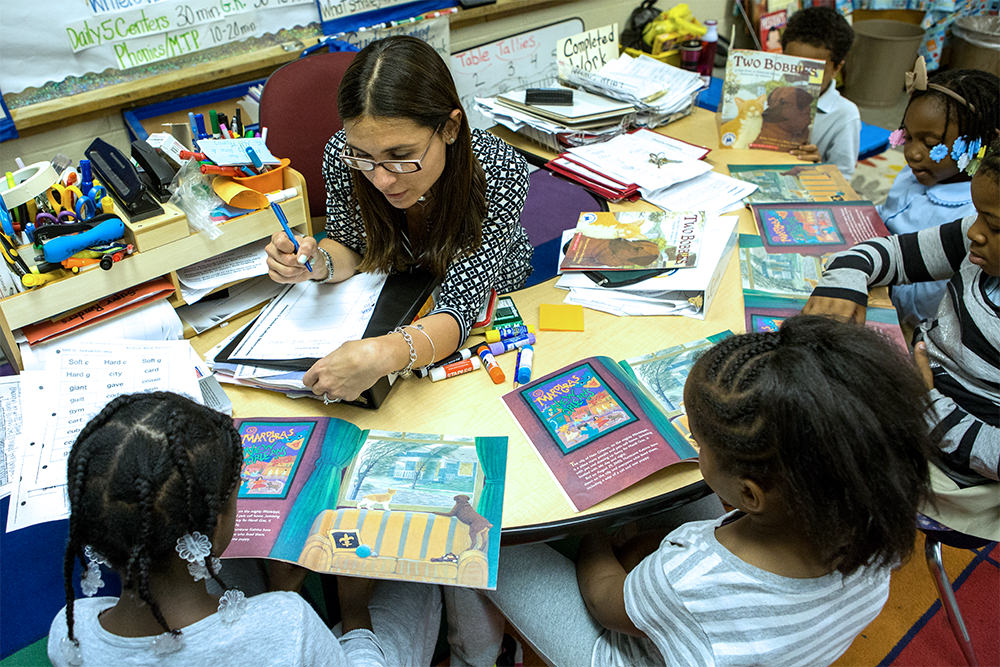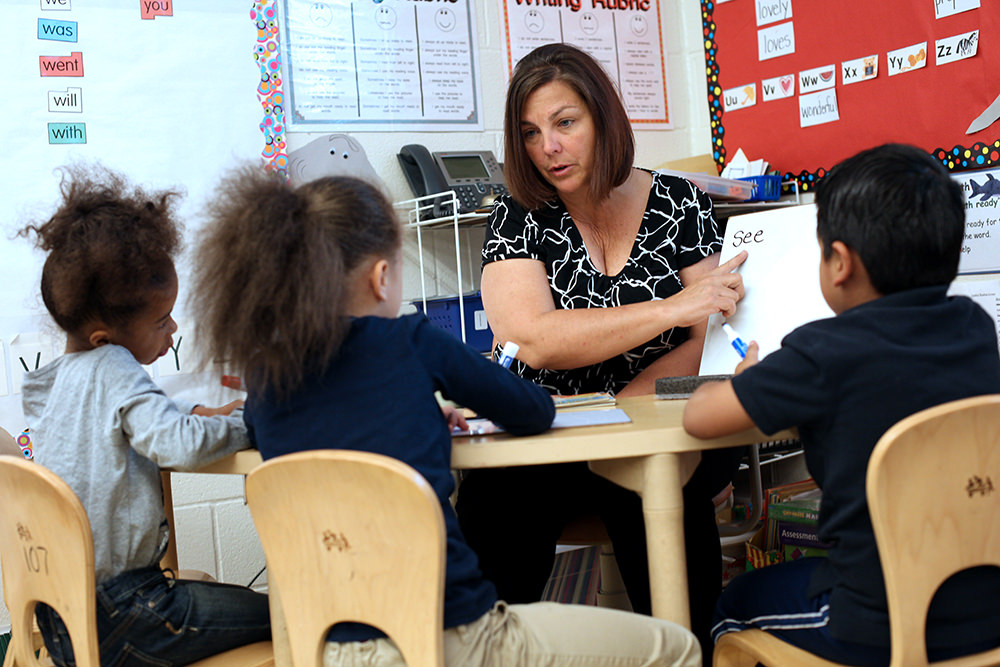
Guided Reading is a powerful and efficient way to differentiate and meet the specific needs of your children while you meet with them in small groups. It gives children a chance to problem solve with new texts in a safe environment and it gives you a chance to build rapport as you work side by side with the children.
Guided Reading in a First Grade Classroom: Zoom Zoom Readers
In this Guided Reading lesson, the teacher models for children how to slow down while reading to make sure that what they are reading looks right, sounds right, and makes sense.
Guided Reading in a First Grade Classroom: Zoom Zoom Readers Directors Cut
View this version of the Zoom Zoom Readers lesson for additional "look fors" and tips.
The purpose of Guided Reading is to help children become independent, strategic readers. When we understand and notice children’s reading behaviors, we can support them and give them exactly what they need to move forward.
“Our teaching role changes during small-group time. Here, we support and scaffold the reader and help the child read as independently as possible. We want each student to problem solve and apply the strategies we have modeled in whole group instruction skillfully. The focus in small-group teaching is on having the child do more of the work than you are. The key is to know your students and find out what they can do during small group time.” - Debbie Diller, Making the Most of Small Groups: Differentiation for All
Guided Reading supports a child-centered approach to instruction. We do Guided Reading because we know that all children:
Can be successful at reading whatever their level. When we meet children where they are and understand how reading develops, we can provide the scaffolding needed for their future growth.
Deserve to be taught at their level. Guided Reading is differentiated instruction at its best. All children deserve access to instructional level texts through which they can be guided to read.
Are responsible for their own learning. Guided Reading asks children to read the text on their own with some teacher support. The teacher notes the areas where they need assistance and provides strategies to scaffold them toward independence. Providing children with the necessary tools for success fosters confidence, motivation, and a sense of responsibility. When children understand their individual strengths and weaknesses, they can create action plans for improvement.
Guided Reading is a powerful and efficient way to differentiate and meet the specific needs of your children. It gives children a chance to problem solve and learn in a safe environment and it gives you a chance to build rapport with children.
“The idea is for children to take on novel texts, read them at once with a minimum of support, and read many of them again and again for independence and fluency.” - Guided Reading, Fountas and Pinnell p. 2.

If you are already doing Guided Reading in your classroom, take a few moments to think about how it is currently going. Use these questions to reflect on your own practice.
How do you currently plan for Guided Reading?
What is your role and the role of the children before, during, and after reading the book?

Can I use my basal for Guided Reading?
Effective Guided Reading instruction depends on children reading texts at their instructional level. Almost every basal has selections at a wide range of text levels, so that one selection might be written at text level G, while the following one is at level M. Therefore, using your basal as the only source of texts for Guided Reading will not be effective or successful. You might be able to use certain basal selections for Guided Reading lessons, provided that these selections are carefully chosen to be at the readers’ instructional level. The importance of leveling the selections to make sure that they are appropriate for your readers cannot be overemphasized.
How many times a week should I meet with each group?
The number of times that a group meets with the teacher each week is dependent upon the number of groups in the class. Most teachers meet with three Guided Reading groups per day. That allows for 15 Guided Reading sessions per week. It is fairly common to have more than three groups in a class. Therefore, you will not be able to meet with every group every day. Meet with your highest support group every day. Fill in the balance of the slots with the other groups, of course keeping in mind that lower level groups will need more of your time than more advanced groups. Remember that Guided Reading is only one component of your literacy instruction. Your children are also benefiting from important literacy lessons in Intentional Read Aloud, shared reading, and independent reading.
Why can’t the children take turns reading a page aloud?
The purpose of Guided Reading is for children to problem solve and practice strategies using level-appropriate text. The role for each child in a Guided Reading group is to apply the focus strategy to the process of reading the entire text – not just a page. The teacher’s role is to support the readers by coaching, prompting, and confirming strategy use. Any format for Guided Reading which is incompatible with this predefined purpose and these predefined roles, such as taking turns reading aloud, would be inappropriate and counterproductive. We know that children love reading aloud and get some real benefit from it. So let’s provide appropriate opportunities for taking turns reading aloud. In partner reading, each child takes a turn reading aloud. In readers’ theater, children take turns reading aloud. They can also take turns reading aloud at the poetry center and the big book center – but not in their Guided Reading groups.
My children are not yet at level A. What do I do with them in a Guided Reading group?
Small group instruction is perfect for children who are not yet reading texts at level A. The small group setting allows the teacher to closely observe the children in order to gather pertinent information about their reading behaviors. Plan a 15 to 20 minute interactive lesson that will engage the pre-A readers in tasks working on sounds, letters, and words. Give them a chance to practice one-to-one matching in level-A texts and apply the lessons on sounds to interactive writing.
How do I select objectives? How do I know what to teach?
All effective Guided Reading lessons start with a literacy objective. Objectives can come from a variety of sources. One of the best sources of information is your anecdotal notes and running records. What are your children doing at the point of difficulty? Another source for Guided Reading lesson objectives is summative assessment data. What skills have the children mastered? What skills do they still need to learn? There are a number of excellent professional books that list lesson foci for each Guided Reading level, including The Next Step in Guided Reading (Richardson, 2009) and The Continuum of Literacy Learning (Fountas & Pinnell, 2010).
How long should children stay on a particular level?
Children continue to receive instruction in books at a given text level until they can successfully read texts at that level with 95% accuracy or higher. You determine this by having the child read an unfamiliar book or a “benchmark book” at that level and taking a running record. The length of time spent at a particular level of instruction varies with the level as well as with the child. It is expected that children will complete six text levels in first grade but only four text levels in third grade. Clearly, children will spend more time reading texts at level N (a third grade level) than they will at level E (a first grade level).
Can I use chapter books in Guided Reading?
Reading chapter books is a threshold that both readers and teachers celebrate. It means that the readers are now capable of processing print fluently and efficiently, holding information in their memories from one day to the next and keeping track of multiple characters and plot lines. The Guided Reading lesson is an appropriate forum for supporting children in making the transition from leveled texts and picture books to chapter books. But once they have successfully made that transition, consider shifting chapter book reading to literature circles instead of Guided Reading lessons. Your chapter book readers will still need targeted instruction during Guided Reading lessons.
In Guided Reading, organization is the key. We need to stay organized and know the learning intention which guide you to come up with a meaningful station or differentiated activities. Just me thinking aloud c",)